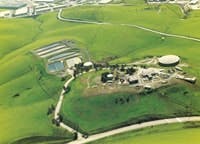The city of Benicia, Calif., must address high levels of dissolved organics in its source water while servicing the water treatment needs of approximately 28,000 residents through a nominally rated 12-million-gal-per-day (mgd) conventional treatment facility. With access to two water sources, the primary source water for the Benicia Water Treatment Plant (WTP) contains high levels of natural organic matter (NOM) with total organic carbon (TOC) levels ranging between 4 and 18 mg/L. While the Benicia WTP has successfully and continually reduced TOC levels by approximately 50% through pretreatment efforts, residual TOC combines with the chlorine gas disinfectant used on site to form moderate levels of trihalomethanes (THMs) leaving the WTP.
The city of Benicia has implemented a series of best management practices to help minimize the formation of THMs in its distribution system and ensure compliance with the Stage 2 Disinfectants and Disinfection Byproducts Rule (DBPR). In addition to minor pretreatment and disinfection process changes, the Benicia WTP decided to monitor THM levels more frequently and use an online analyzer to provide accurate and timely information regarding THM levels in its treated water.
Monitoring THM levels with an online analyzer has enabled the WTP to optimize enhanced coagulation and disinfection residual based on the total THM concentration reported throughout the day. The online THM analyzer has been fully integrated into the THM control strategy after nine months of continuous use, serving as an essential element to ensure Stage 2 DBPR compliance.
Treatment Challenges
Raw water for the Benicia WTP primarily comes from two surface water sources originating 50 miles away. The first source is the North Bay Aqueduct (NBA); the second is the Solano Project. A third raw water source is the city-owned Lake Herman, which serves as an emergency source of water with approximately 30 days of storage during highest demand.
Prior to 1988, the Solano Project delivered a source water low in NOM (dissolved organic carbon at approximately 50% of the TOC loading). In 1988, the North Bay Aqueduct went online, and the Benicia WTP made this its primary source due to ample quantity and generally good water quality. The NBA, however, delivered significantly high levels of NOM, especially after heavy precipitation runoff with dissolved organics representing 80% of the TOC loading. High levels of NOM in source waters are a precursor for the formation of disinfection byproducts such as THMs.
The higher levels of NOM in the NBA source water posed a major challenge for the city. Pre-treatment efforts successfully reduced TOC levels by approximately 50%. Enhanced coagulation accounted for approximately 40% of the reduction, and absorption with granular activated carbon (GAC)/sand dual media filters accounted for approximately 10%.
THM speciation is composed of approximately 80% chloroform, followed by 20% bromodichloromethane, 0% dibromochloromethane and approximately 0% bromoform.
Treatment Approach
The Benicia WTP employs a conventional treatment process including coagulation-flocculation, sedimentation, GAC filtration and chlorine gas disinfection. Despite a 50% reduction of TOC levels during pretreatment, operational costs to further reduce THM levels included alum sludge removal annually, granular activated carbon replacement every six years, and switching over to Solano Project water during the winter months because of the high NOM in the NBA source water. Pumping Solano Project water to the Benicia WTP includes the higher cost of water and the electrical energy for the 200-hp motors.
In 1994, the Benicia WTP commissioned a study to evaluate the possibility of blending source water from the NBA and the Solano Project so the influent quality reaching the plant would contain lower levels of NOM. The study showed adequate pump capacity to accommodate blending of the two source waters during the problematic months of December through March when TOC levels in the NBA source water were highest. Continued runoff from the surrounding foothills delivers high NOM concentrations in the NBA source water well into May.
Operators at the Benicia WTP already were working to reduce TOC levels through source water blending and pretreatment process stages. With the advent of the Enhanced Surface Water Treatment Rule, they began to focus efforts on reducing THMs leaving the plant and minimizing the formation of THMs in the distribution system.
Instead of altering its treatment processes, the Benicia WTP looked to employ best management practices (BMPs) for THM control and strategy using existing schemes. The WTP staff maintained “super” enhanced coagulation through the use of acidified alum, controlled the disinfectant of filter effluent to minimize the amount of free chlorine in the system, turned over the reservoirs on a daily basis to reduce water age, flushed the distribution system on a weekly basis and replaced GAC media every six years. Real-time fluctuations in THM levels, however, were difficult to characterize based on the frequency of quarterly grab samples and timing of analysis. The turnaround time to receive results from external laboratory analysis proved too long to implement proactive management of THM mitigation strategies.
Monitoring the real-time correlation between operating conditions and THM levels was imperative. Some locations throughout the distribution system were experiencing high levels of THMs due to residence time and the age of water. As the utility began to explore the costs associated with issuing two daily samples to an external laboratory for analysis, it learned about an online THM analyzer capable of providing immediate results and measurements for Total THM and the chloroform specie via an automated colorimetric process. As a result, the Benicia WTP entered into a six-month bench trial to study the effectiveness of using the THM-100 online analyzer from Aqua Metrology Systems to accurately measure THM levels in finished water leaving the facility.
The automated online THM analyzer uses an approved “purge-and-trap” sampling method, followed by desorption into a chemical mixture that generates a colored product and time-resolved spectrophotometric analysis for detection and determination of THM levels. Typically scheduled to take measurements every six hours, the Benicia WTP set the self-calibrating system to sample every four hours so it would coincide with other water quality measurements and sampling scheduled at the facility.
Shortly after installing the online THM analyzer in October 2012 and establishing baseline THM data, the utility began to undertake weekly process changes to determine the effect on THM levels. The controlled experiments only included the testing of conditional changes that would improve water quality, because testing of conditions that might have a detrimental effect on water quality would hinder the ability to provide high quality water to the customer base. Prior to undertaking the controlled process changes, the accuracy of the online monitor and its repeatability against certified laboratory data was verified. Results in Figure 1 and Figure 2 demonstrated that the online THM analyzer yielded better results than laboratory methods.
During the first six months of testing (October 2012 to March 2013), the Benicia WTP underwent individualized controlled testing for a variety of conditions with the goal of maintaining THM levels consistently under 40 parts per billion. The online analyzer provided accurate and timely information regarding THM levels in treated water. Daily THM results provided the operational staff with real-time feedback on the implication of process changes on THM levels in the finished water. As THM levels fluctuated, the operational staff would apply BMPs accordingly to adjust for an increase in THM levels.
Controlled test conditions included:
- • Increasing acidified alum to drive pH down to 6.3 to 6.5;
- • Reducing post disinfection to maintain treated water free chlorine residual at
- 0.9 mg/L; and
- • Reducing caustic soda feed to maintain the Langlier Saturation Index of 0.0.
Following the initial six-month period, the Benicia WTP decided to extend the trial for an additional three months to enable the measurement of variations in THM formation during the change of source water that extended through May. The extension of the trial also enabled the operations team to continue to measure THM fluctuations as they worked to optimize process controls and treatment schemes.
Optimizing Plant Performance
High levels of organic material will remain present in source water as the Benicia WTP works to maintain compliance with Stage 2 DBPR requirements. Continuous demonstration of THM formation due to source water and process conditions is made possible through the use of the online THM analyzer. Operators have been able to optimize plant performance and chemical dosage, allowing them to economize plant chemicals and dose pace accordingly. Treatment anomalies have been detected early, enabling immediate correction to process controls. The integration of the online THM analyzer at Benicia WTP has become an essential element to avert regulatory breaches and deliver treated water of the highest quality to the city of Benicia.
Real time streaming data for Total THM values at the city of Benicia is available at http://www.tthmalert.com.
Download: Here


